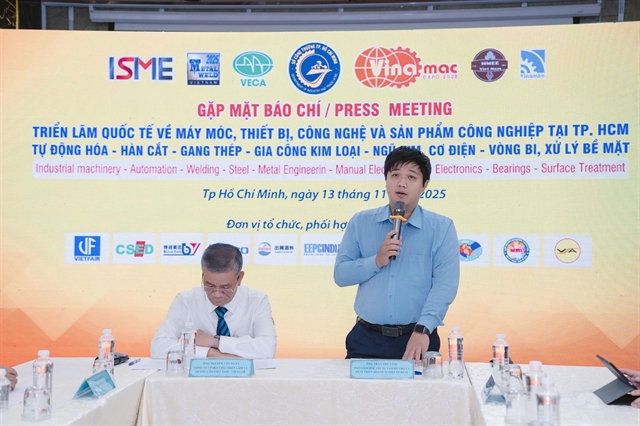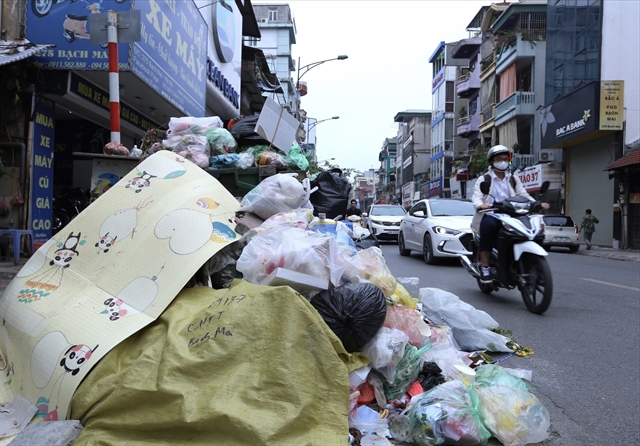 Opinion
Opinion


|
| Waste is piled up by the side of Bạch Mai Street, Hai Bà Trưng Street on October 25. Rubbish has not been collected for two days as residents of Sóc Sơn district’s Nam Sơn and Hồng Kỳ communes are blocking garbage trucks from entering Nam Sơn waste treatment complex, blaming local authorities for slow compensation to relocate from the area.. VNA/VNS Photo Hoàng Hiếu |
Nguyễn Mạnh Hùng, head of Technical Infrastructure Division under the Hà Nội Department of Construction speaks to Tiền Phong (Vanguard) newspaper about difficulties in resolving garbage crisis in the city.
According to local residents, environmental pollution does not only affect households living within 500-1,000m of the dump but the stench from the landfill has a wider effect. What’s your opinion on this?
The influence of the dump has been determined by competent agencies. Regarding the management and operation, at present, all burial compartments and waste water containers are covered with tarpaulins to prevent odours. However, there are still times that they are uncovered to receive garbage in the landfill during the treatment process.
I can confirm that normally, the smell is acceptable, but it is getting worse and spreading further with the weather changes.
The city's municipal waste treatment requirements are very urgent, and the waste crisis has occurred many times. What are reasons for low progress of upgrading plants to handle the city’s waste? Is there a capital shortage or a lack of proper technology to deal with the problem?
Waste treatment technology in the world is changing very quickly. Currently, there are many technologies for countries to apply depending on their specific conditions. However, experts said the technology of waste incineration without classification to generate electricity is the most appropriate option.
The city is promoting a project to build a generating power incineration plant using new technology which is capable of treating 4,000 tons of waste a day. It is expected to be put into operation early next year.
Once the construction of the plant is complete, the garbage-related crisis will be basically solved because the Nam Sơn Waste treatment receives around 5,000 tonnes of rubbish per day.
The Department of Construction has repeatedly proposed the municipal authority speed up investment in waste treatment. Waste treatment technology currently deployed in the country has revealed many shortcomings and does not meet environmental standards.
With the application of new technology, there emerges another problem – the cost of waste treatment is much higher than traditional burial methods. Investors are wary due to the fact that it will require large investment.
Regarding garbage disposal, the Ministry of Construction has issued regulations on ceiling prices. The waste incineration technology that Hà Nội is implementing is the latest one and the price is not included in the ministry’s regulations.
According to the ministry’s guidance, the project has been deployed first and the price would be calculated in practice before submitting to the ministry for approval. The capacity of treating only 800 tons per day for a plant is no longer suitable.
As far as I know, waste disposal in many countries is many times higher than Việt Nam. The application of different technology resulted in different waste treatment unit prices.
To mobilise resources for waste treatment, the city has repeatedly set a waste disposal fee to households. What has been done so far ?
Many countries charge high fees for household waste disposal while in Việt Nam it is still basically receiving subsidy. If we collect this fund, it add more resources to waste treatment, attracting investors and raising people's awareness of environmental protection. The Department of Construction has set up fee level for this service and reported it to the city.
I want to emphasise that the site clearance must be accelerated. Due to that issue, many projects are behind schedule. Nam Sơn waste treatment area has two parts - the north and the south. According to the plan, the land dedicated to northern landfill area should have been handed over by 2016, but in reality, it has not yet been completed. As a result, the entire amount of rubbish was treated in the southern disposal complex, leading to the waste crisis. — VNS